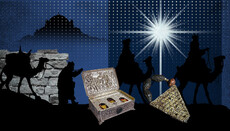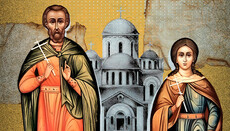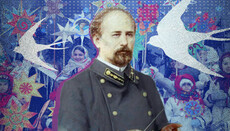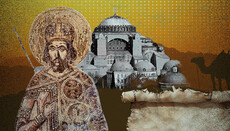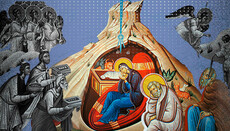III Ecumenical Council: Virgin Mary – Mother of God or Mother of Christ?
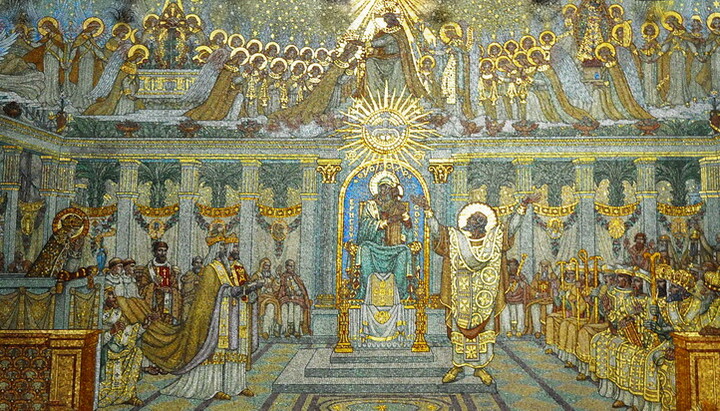
The III Ecumenical Council (431) ushered in a new era of Christological disputes. Triadological disputes about the Trinity were replaced by those about Jesus Christ.
Discussions about who Jesus Christ is, how He embodies the Divine and the human, how the Son of God, the Eternal Logos, correlates with the Son of Man, Jesus of Nazareth, could not but arise in the Hellenic environment. Indeed, the issue of birth from a “god” and an earthly woman is far from new for this and other cultures.
In Hellenic mythology, there is a whole class of beings who are called "demigods" or "heroes." For example, the legendary Hercules is the son of Zeus and the earthly woman Alcmene. However, firstly, creatures came to earth, which, although they were called "gods", they were "one of" with a small letter. Secondly, all such theophany, i.e. the emergence of "gods" on earth was perceived by people mainly as a myth, not a historical fact. Christians, on the other hand, argued, firstly, that God incarnated with a capital letter, the unlimited Absolute, the Creator of all things. Thirdly, they affirmed the reality of the Incarnation, the historicity of Christ.
The Lord Jesus Christ lived on earth really, not mythologically. He walked, talked, ate food, wept, mourned, suffered during the tortures and on the Cross, experiencing absolutely real pain.
He was judged by a specific Roman official Pontius Pilate, He was pierced with a spear by a specific Roman warrior Longinus. Finally, He resurrected and ascended into Heaven. How, at the same time, did the Divine and the human blend in Him, what acted and what suffered, how many natures and personalities were in Christ, and where did one end and another begin? All these questions could not but bother the minds of Eastern theologians.
By the end of the 4th century, these questions and attempts to find answers to them came out, as we would say now, into the public plane and began to be actively discussed by Christian thinkers and theologians.
Theological background of the Council
The heresy, which was rejected by the III Ecumenical Council and which received the name of Nestorianism, arose among the Antioch theological school as a reaction to another heresy, Apollinarianism, which was preached by the most authoritative theologian and staunch opponent of Arianism, Apollinaris of Laodicea. Reflecting on the union of the Divine and the human in Christ and proceeding from the premise that a person consists of a body, soul and spirit (mind), Apollinaris tried to explain this union rationalistically. It was self-evident to him that two completely different entities could never unite into one and constitute one person.
For example, he gave the argument that two different physical bodies cannot be placed in one space. Apollinaris argued that in Christ, the spirit (mind) was replaced by the Divine Logos, the Son of God. He said, "Christ is not just a man, but like a man, for he is not consubstantial with man in the main part, in mind." He backed up his statement with a quotation from the Apostle Paul that the Son of God “…rather, he made himself nothing by taking the very nature of a servant, being made in human likeness.…” (Phil 2:7).
Strictly speaking, Apollinarianism was rejected as a heresy by the First Rule of the Second Ecumenical Council, but as if in passing, along with other heresies.
In opposition to this teaching, the theologians of the Antiochian school, Diodorus of Tarsus and, especially, Theodore of Mopsuetia, categorically affirmed that Christ had a complete, perfect human nature, with body, soul, and spirit. Otherwise, the salvation of man (with all three components) is impossible. In this respect they followed the main precept of the theology of St. Athanasius the Great: "What is not accepted by the God-man is not saved."
Everything would be fine but for one thing: the Antiochians could not go beyond the conceptual apparatus of Aristotle, according to which such concepts as “essence”, “nature” are per se not real but abstract concepts. Only their "hypostasis", "face" makes them real. They argued that in reality "there is no non-hypostatic nature." Thus, they concluded that since there are two complete natures in Christ, there must be two hypostases, two persons. Of course, they stipulated that in Christ these two full hypostases, the Divine and the human, are incomprehensibly united into one Person, but nevertheless.
The practical conclusion from this statement was that, as Theodore of Mopsuetia said, it is wrong to call the Blessed Virgin the Theotokos, but rather the Human Mother.
By the way, when he began to call for this from the pulpit, the people were indignant, which indicates that at that time the veneration of the Virgin Mary precisely as the Mother of God was commonplace.
The Alexandrian school revolted against the theology of the Antiochenes. The Alexandrians had a somewhat different conceptual framework and theological language. For them, the unity of Christ was the absolute priority. Moreover, this unity did not boil down to the unity of the Hypostasis, but extended to nature. They argued about the unity of Christ not only by hypostasis, but also by nature, of course, stipulating that this is a unity of two.
The famous formula of the Alexandrians: is "the one nature of God the Word incarnate." They taught that from the moment of the Incarnation, the Divine and human natures in Christ are separated only abstractly, speculatively, but in reality it is necessary to affirm the unity of Christ. Monophysitism subsequently grew out of this theology, which exists today as an official teaching in many so-called pre-Chalcedonian Churches: Armenian, Coptic and others.
So, let us repeat: the Antiochian school, in the person of Theodore of Mopsuetia and then Nestorios, asserted that two natures in Christ give grounds to speak of two hypostases, while the Alexandrian school said that the single Hypostasis of Christ gives grounds to speak of one nature.
Political Background of the Council
It is likely that these theological disputes would sooner or later lead the disputants to agreement, to the development of a common terminology, to honing of the meaning of concepts and terms, but here big church politics intervened.
The II Ecumenical Council, by its Third Canon, approved the preeminence of the honor of the Archbishop of Constantinople, placing him second after the Pope of Rome, but the position of the Archbishop of Constantinople was ambivalent. On the one hand, its canonical territory was limited only to the capital.
The attempts of St. John Chrysostom to interfere in the affairs of the Church in Ephesus and Asia Minor were blamed on him and became one of the arguments for his removal from the see.
But on the other hand, the very presence in the capital of the empire, proximity to the emperor and the highest dignitaries endowed the Archbishops of Constantinople with enormous actual power and influence. Both authoritative Local Churches, most often Alexandria and Antioch, as well as various political parties in Constantinople itself entered into the struggle for who would head the metropolitan see.
Sometimes intrigues reached such a level that the emperor and his court preferred by their decision to call a completely third-party candidate, equidistant from local political parties, to the chair. Such a candidate at one time turned out to be the presbyter of Antioch, the future Saint John Chrysostom, the same candidate in our case was Nestorius, who was called to Constantinople from the monastery of St. Euprepius.
Nestorius
Nestorius received his theological education in Germanicia, Athens and Antioch, where he listened to the lectures of Theodore of Mopsuetia and became his best student. At the same time, Nestorius was so zealous in defending his views that Theodoros urged him to be more moderate and restrained. Having become, at the direction of the imperial court, the Archbishop of Constantinople, Nestorius began to furiously eradicate various heresies in the capital. He did this, of course, with the help of imperial power. “Give me a land cleansed of heretics, and I will give you heaven,” he said to Emperor Theodosius II.
In addition to obvious heretics, various religious movements that did not fully agree with the official doctrine were subjected to repression.
Nestorius also banned theaters, concerts, dances, athletic competitions and similar events in the capital, which turned against himself both the townspeople at large and many those in power. But the most reckless act of Nestorius was that he accepted for consideration the appeals of clerics from other Local Churches. For example, he considered the complaints of some Alexandrian clerics against Cyril of Alexandria, an authoritative and powerful hierarch who, along with the Roman bishop, bore the title of pope. Saint Cyril could not stand this and waged war against Nestorius, and the most convenient reason for such a war was the accusation of heresy, especially since Nestorius provided enough reasons for this.
Thus, in a specific situation, the struggle for Orthodoxy became a cover for the struggle for personal ambitions, while in a historical perspective, on the contrary, personal enmity turned into the triumph of Orthodoxy.
Events leading up to the Council
Having occupied the See of Constantinople, Nestorius began to openly preach the teaching of Theodore of Mopsuetia on the separation of the two natures of Christ, Divine and human, together with their hypostases. He said that Christ is both the "Temple" and "the Almighty God living in it", that "the man worshiping with God" lives in this "Temple".
One of the presbyters of Nestorius, a certain Anastasius, went even further, who publicly called for abandoning the name of the Virgin Mary as the Mother of God and replacing it with the “Human-bearing”.
The believing people were outraged. Nestorius proposed a compromise option – "The Mother of God" or "God-Receiver".
He also believed that it is impossible to use such phrases in relation to Christ as “the eternal child”, “God fed on milk” and the like. Saint Cyril did not fail to take advantage of all this. He began to write polemical letters refuting the teachings of Nestorius and sent them to Emperor Theodosius II, Empress Eudoxia, the influential sister of Emperor Pulcheria and other high dignitaries, as well as to authoritative monasteries.
Saint Cyril of Alexandria
In addition, Cyril wrote to Pope Celestine in Rome, calling him “the most holy father” (Nestorius in his letters addressed the pope as “fellow brother”). Also, the clergy of Constantinople, offended by Nestorius, appealed to Rome. All this turned Pope Celestine against Nestorius, and in 430 he convened a Council in Rome, at which he condemned the teachings of Nestorius in the form in which Cyril had presented him.
In general, the decisions of this Council, even according to Catholic historians, were unheard of and looked as the height of the pope's claims to supremacy in the Church. Pope Celestine canceled all the prohibitions imposed by Nestorius on the clergy of Constantinople, and demanded that he renounce his teaching within 10 days under the threat of anathema. The Pope of Rome entrusted the execution of his decisions to Pope Cyril of Alexandria, the implacable enemy of Nestorius.
Cyril gathered his own Council in Alexandria, which confirmed the decisions of the Council of Rome and, in addition, approved Cyril's accusatory letter to Nestorius, which contained the famous "12 anathematisms" of Cyril.
These anathematisms, designed to denounce the heresy of Nestorius, also contained heretical teaching, but of an opposite nature, or rather, heretical formulations, such as "God suffered in the flesh" and the like. The theologians of Antioch saw in this Apollinarianism, already condemned by the Second Ecumenical Council, and convened their own Council, at which they thoroughly and scrupulously refuted the theological theses of Cyril. Cyril, sensing the seriousness of the arguments of the Antiochenes, wrote a theological treatise in defense of his "12 anathematisms". Nestorius wrote his "12 anathematisms" on Cyril's anathematisms.
Under these circumstances, Emperor Theodosius II issued a decree on the convening of an Ecumenical Council in Ephesus on the next Pentecost of 431.
Holding the Council
Organizationally, the III Ecumenical Council was the most chaotic and disorderly of all. It was not officially opened and properly completed. The confusion began already in the imperial decree, which did not indicate who had to preside at the Council, nor what issues had to be discussed, nor how many and which bishops had to be present at it. Metropolitans were invited, i.e. heads of metropolitan districts, with "several bishops". But no specific number of bishops was specified.
At the same time, various Local Churches had different traditions with the division of these metropolitan districts. There were many such districts in Antioch, but almost none in Alexandria. For this reason,v Antioch could be represented at the Council by a much larger number of bishops than Alexandria. Naturally, Cyril could not allow this to happen and brought with him about 50 bishops, as well as many clerics and monastics.
In addition, Cyril carried out much more powerful agitation than Nestorius, who hoped for the protection of the imperial court and the support of the Church of Antioch. Cyril formed a fairly broad coalition with his messages, including Rome, Asia Minor, Cyprus, Palestine, and so on.
The theology of Nestorius looked clearly more heretical than the theology of Cyril, so many understood that the truth was on the side of the Pope of Alexandria, and besides the truth, there was also strength in the form of the position of Rome, Egyptian monasticism and other ecclesiastical and non-ecclesiastical circles. Cyril's victory was more likely, but not obvious. This gave some Churches a chance to resolve their "personal" issues in exchange for supporting Cyril's position, which already looked truer than that of Nestorius. This is how the Jerusalem and Cypriot Churches formalized their autocephalous statuses.
The date of the Council indicated by the emperor was June 7, 431. Cyril and the large delegation accompanying him arrived in Ephesus ahead of time, but neither the bishops from Antioch nor the papal legates had time to arrive by this date.
The Antiochians sent couriers ahead of them, who asked those gathered at the Council to wait for their arrival, but made a reservation that if this was not possible, the Council could open without them.
Here lies a very important detail: the Antiochians agreed to the opening of the Council in their absence, but not to the adoption of decisions. Cyril of Alexandria, as the most authoritative and enterprising hierarch of those who had already arrived, single-handedly decided to take over the chair and begin conciliar sessions. On June 21, there was a solemn meeting, and on June 22 - already a working one. At this working meeting, however, a vote was taken whether to open the Council or not. The results were remarkable and mixed: 16 metropolitans with 150 bishops were in favor, while 21 metropolitans with 68 bishops were against.
It was not known how to count – by bishops or by metropolitans. In fact, the Council began its work despite the protest of the imperial envoy, a certain official Candidian, who still asked to wait for the papal legates and the delegation of Antioch.
Everything was decided in one day: the works of Nestorius were read, excerpts from his sermons, the polemical messages of Cyril, including his "12 anathematisms", as well as the message of Pope Celestine, which was mentioned above.
The Council recognized the teachings of Nestorius as heretical, while the teachings of Cyril – Orthodox. Nestorius, along with the bishops and metropolitans who supported him, were invited to the Council, but they did not come, declaring that the Council was invalid in the absence of Antiochians and papal legates. Nevertheless, the Council pronounced the following sentence on Nestorius: “Through the lips of the Holy Council, the Lord Jesus Christ himself, whom Nestorius blasphemed, deprives him of episcopal and priestly dignity.” Candidian immediately declared that the Council was illegal, and wrote a report to the emperor, so did Nestorius.
The Antioch delegation headed by Archbishop John arrived only 4 days later, on June 26, and was surprised to learn that everything had been decided without them. Together with the bishops who remained faithful to Nestorius, they composed their own Council, which they called the Council of the "Eastern Diocese" with a list of dioceses. This Council, in turn, recognized the “12 anathematisms” of Cyril as heretical, and the teaching of Nestorius as Orthodox. At the same time, they declared Cyril and all his supporters deposed.
Emperor Theodosius II, who already knew about the meeting on June 22, but did not yet know about the Council of the "eastern diocese", sent an order to cancel the decisions of the Council of June 22, but at the same time ordered the bishops not to disperse and wait for his new envoy with further instructions.
At this time, papal legates arrived with instructions from Pope Celestine to support the position of Cyril. Cyril convened the next meetings of the Council on July 10 and 11, at which the pope's message was read, the minutes of the meeting on June 22 were announced, which the legates approved and signed. Meetings were also held on July 16 and 17, to which John was invited along with the Bishops of Antioch, but they did not attend them. In the meantime, a new representative of the emperor arrived, bringing orders for the arrest of both Cyril of Alexandria and John of Antioch, and the local Bishop of Ephesus, Memnon, was arrested with them.
For some time, the imperial entourage thought about what to do with all this, and in the end decided to recognize both the decisions adopted at the meeting on June 22 on the deposition of Nestorius, and the decisions of the Council of the "Eastern Diocese" on the deposition of Cyril, declaring them to be decisions of one and the same Council.
The rest of the bishops were invited to reconcile with each other. The decision is very strange and in fact does not solve anything. For its announcement, the emperor's envoy, the Minister of Finance John, called all the bishops to him. Some did not come, and those who did were so intransigent to each other that John wrote to the emperor in his report:
“In order to prevent an outbreak of a fight, I squeezed detachments of soldiers between the converging groups of one and the other party. Because of the rage they oozed, which I don’t know where it came from <…> the most God-loving bishops were inexorably hostile to each other, but I don’t know why they ended up having such bitterness and defilement.”
In this atmosphere of mutual depositions, Kirill and his party continued to send messages in defense of their position. They were supported by the monastic circles, who made up a whole deputation to the emperor, which was headed by the famous Constantinople ascetic Dalmat, who had been in seclusion for 46 years.
The monks claimed that Nestorius was a heretic. Soon Nestorius, for the sake of church peace, agreed to leave the metropolitan see and retire to a monastery. Emperor Theodosius sent an order to Ephesus, which stated the failure of his attempts to reconcile the warring parties through the Council, and the Council itself was declared dissolved.
Events after the Council
Instead of Nestorius, a certain presbyter Maximian was elected to the See of Constantinople, who had previously been an Apocrysiarius, i.e. a mediator between the papal and imperial courts in Rome. Having failed with the Council of Ephesus, the imperial entourage did not abandon attempts to reconcile the warring parties. The emperor wrote to both Cyril of Alexandria and John of Antioch, calling them to come by for reconciliation. Both of them, by that time already released from arrest and returning to their dioceses, refused. Then the imperial notary Aristolaus was sent to them with an intermediary mission, who, by persuasion and threats, forced them to reconcile.
Cyril was criticized for his authoritarian methods by his own monk, the famous ascetic, the Monk Isidore Pelusiot.
At the same time, the theological controversy continued. Cyril wrote an explanation of his "12 anathematisms" that generally satisfied the Antiochians. He also stopped insisting on their universal validity.
Finally, in 433, a statement of faith was signed by all parties, which, in general terms, was the statement that the Antiochians brought to Ephesus and which Cyril, in the heat of the struggle, did not allow to be read at the Council. It looks as follows:
“Therefore, we confess that Our Lord Jesus Christ, the Only Begotten Son of God, is a perfect God and a perfect man with a rational soul and body, Born in Divinity from the Father before the ages, in the last days He Himself was born according to humanity from the Virgin Mary, for our sake and salvation. Consubstantial with the Father in Divinity, and He is the most consubstantial with us in humanity. For there was a union of two natures. Therefore, we confess the One Christ, the One Son, the One Lord. In accordance with this idea of unmixed unity (nature), we profess St. Virgin as the Mother of God, and this is because God – the Logos incarnated and became human, and from her conception united with Himself the temple received from Her. We recognize the gospel and apostolic expressions about the Lord: some are unifying, as referring to one person, and others are dividing, as referring to two natures. Furthermore, some (expressions we recognize) as conveying godly (properties) according to the Divinity of Christ, and others – humiliated (properties) according to His humanity.”
A concession on the part of the Antiochenes was an agreement with the condemnation of Nestorius. In a letter to Cyril, they wrote, “For the sake of church peace, in order to stop strife and temptations, we agree to have Nestorius, who was once the archbishop of Constantinople, deposed, and to anathematize his bad and nasty new words” (what kind of “new words” were not specified). Reconciliation took place, Cyril of Alexandria celebrated the liturgy with the envoy of the Church of Antioch, Bishop Paul of Emesa, mutual anathemas and depositions were forgotten by default.
Conclusions
Surprisingly, the Ephesian Council, which was poorly organized, disgracefully conducted, neither started nor completed, and formally did not even take place, is nevertheless revered as the III Ecumenical Council and is recognized by almost all Christian denominations. Despite all its shortcomings, the Church, led by the Holy Spirit, accepted its decisions and included them in Her Sacred Tradition. God works in mysterious ways.
The Council of Ephesus shows us how important the shades of meaning of theological formulations and statements were for its participants. Personal relationships, grievances and confrontations could not lead to such a fierce upholding of their positions. The parties defended their religious beliefs even in defiance of the imperial will and at the risk of incurring grave consequences.
The reason for such a zealous attitude is that they were fully aware of the destructiveness of heretical beliefs, albeit most sophisticated, for their own souls. They agreed that true faith is salvific and heresy is not, although they differed in understanding what true faith is and in what theological formulations it should be translated.
This is what we, today's Christians, lack. Today, tolerance is in vogue, reaching the point of recognizing that a person can believe in false dogmas or not know them at all, can clearly violate the commandments of God and contradict the Holy Scriptures in his public statements and at the same time be called a “good Christian”.
Today, from the lips of church hierarchs, one can hear calls for uniting everyone with everyone, regardless of differences in faith and morality. The Fathers of the Third and actually of all the other Ecumenical Councils thought differently.
